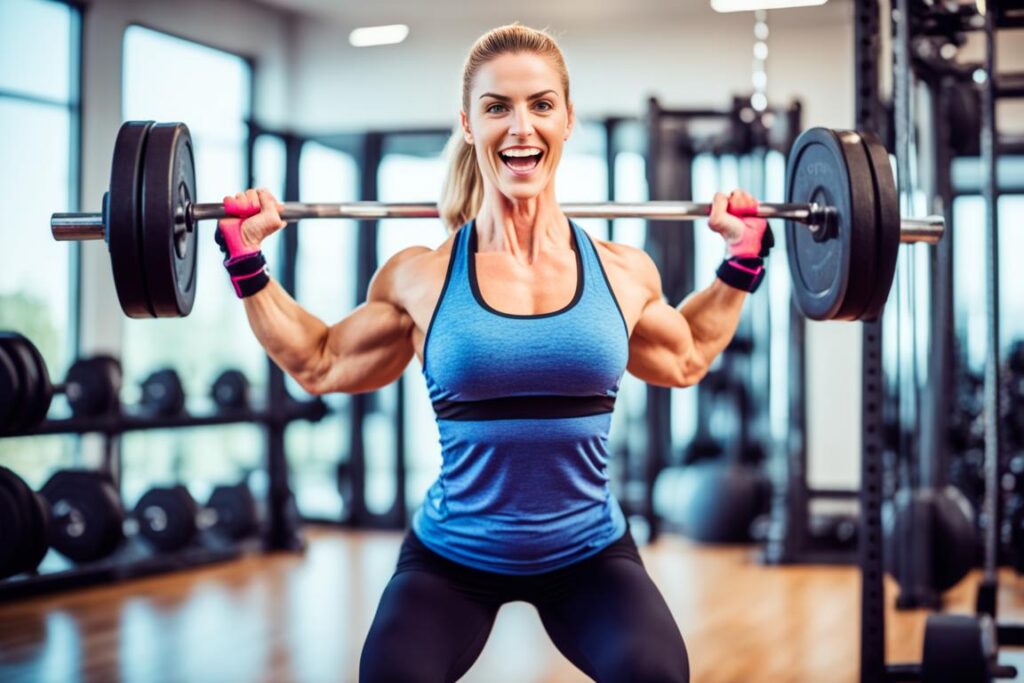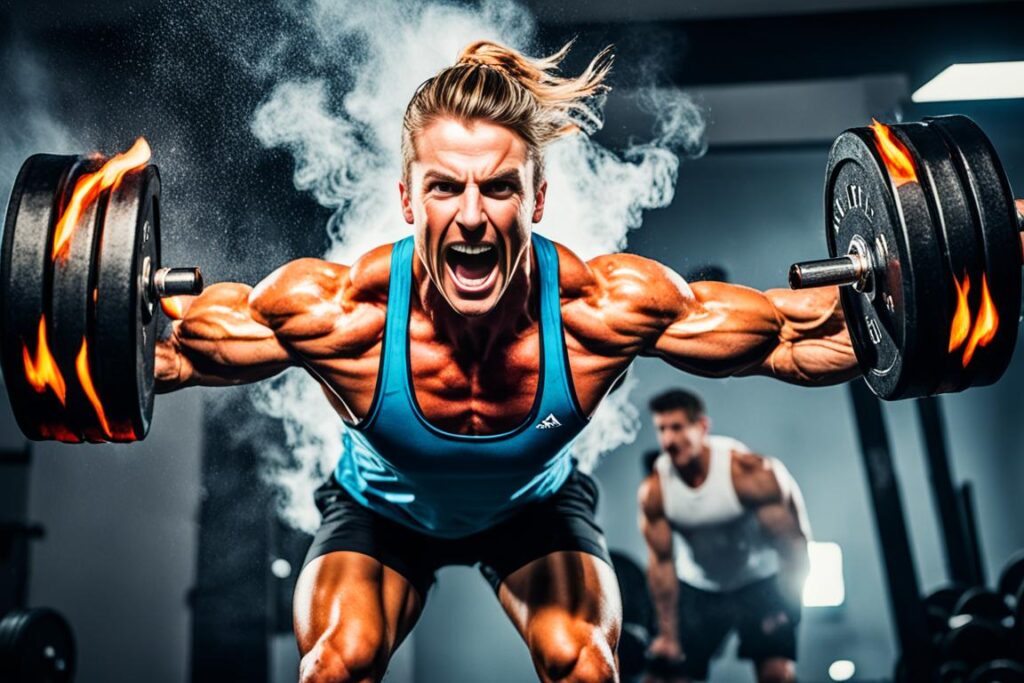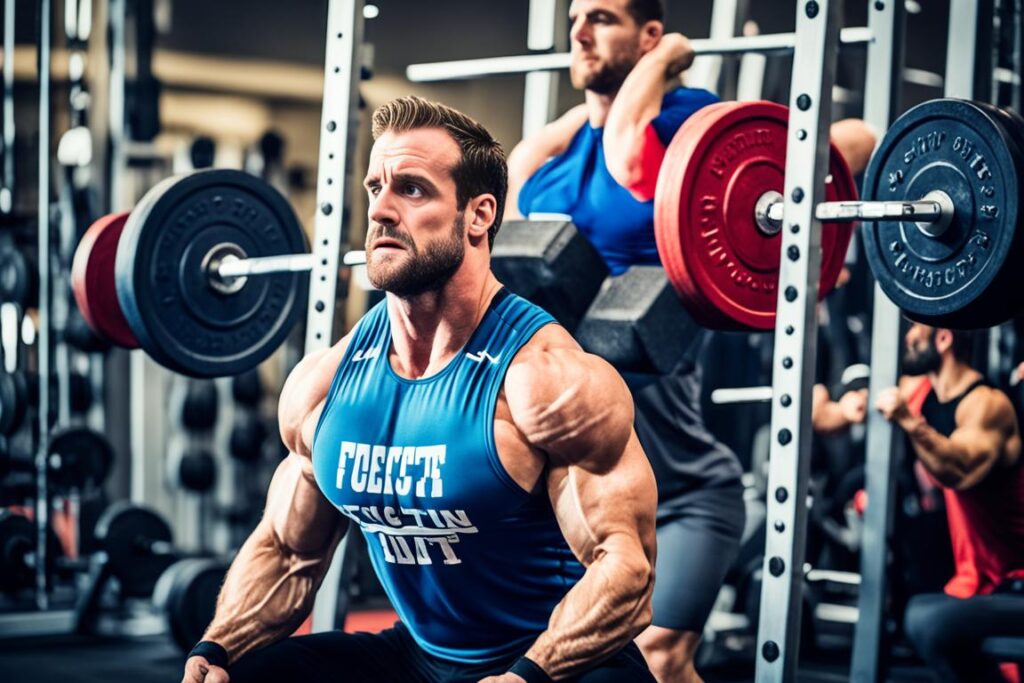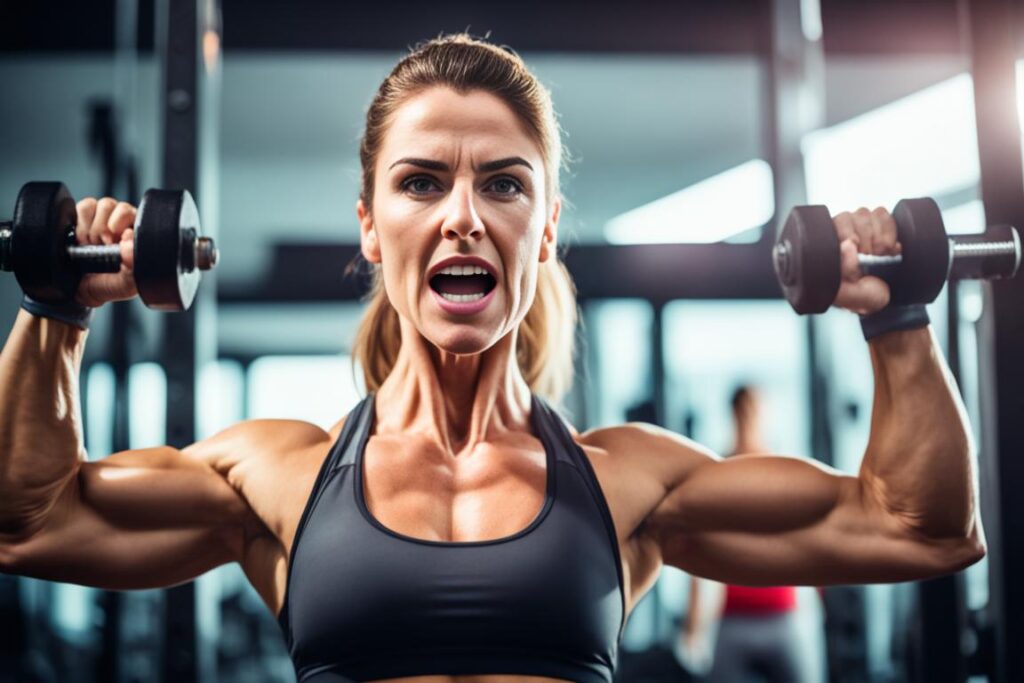Did you know a 180-pound person burns about 410 calories in a weightlifting session? This fact highlights weight lifting’s vital role in fat burning. While many choose cardio for weight loss, adding weight lifting has significant benefits.
The Centers for Disease Control and Prevention (CDC) say weightlifting for 30 minutes burns around 110 calories. Though less than HIIT’s calorie burn, weight training boosts your resting metabolic rate. This means you burn more calories all day, even when not working out.
Weight training also builds lean muscle, improving your body shape and strength. Combining your muscle-building with high-energy workouts like HIIT can maximize calorie burning. This approach aids in sustaining weight loss and boosting fitness levels.
Key Takeaways
- Weightlifting can burn approximately 110 calories in 30 minutes.
- Building lean muscle mass can boost your resting metabolic rate.
- Incorporating HIIT with weight lifting can maximize calorie burn.
- Weight lifting benefits for weight loss include increased strength and enhanced body composition.
- Understanding the balance between calorie intake and energy expenditure is crucial.
The Benefits of Weight Lifting for Fat Loss
Weight lifting is more than strength building; it’s key for shedding fat. It boosts your resting metabolic rate, making you burn calories even while idle. A study in 2020 showed resistance training raises this rate better than aerobic exercises do.
Additionally, lifting weights is great for gaining lean muscle. This muscle uses more energy than fat, helping you lose weight. The afterburn effect also helps, burning calories long after you finish your workout. This is how weight lifting aids in fat loss and can reshape your body more effectively than just cardio.
Increase in Resting Metabolic Rate
Lifting weights can greatly increase your resting metabolic rate. This means your body burns calories even when you’re not moving. Resistance training raises this rate better than aerobic or mixed exercises. This is why adding weight lifting to your workout is key for losing fat steadily.
Building Lean Muscle Mass
Building lean muscle is another big plus of lifting weights. Muscle burns more calories than fat, upping your calorie burn. Lifting regularly not only helps you lose weight but also shapes and tones your body. Plus, it can make your bones stronger and keep injuries at bay, boosting your health long-term.
Afterburn Effect
The afterburn effect is a major perk of weight lifting for losing fat. Your body keeps burning calories after you lift as it heals muscles and cleans out lactate. This can keep your metabolism high for hours post-workout. By focusing on weight lifting, you enhance this afterburn effect, helping you burn more calories all day.
Best Weight Lifting Exercises for Fat Burn

Some exercises are top-notch for fat burning because they use many muscle groups at once. These are called compound movements. Adding these to your routine speeds up fat loss and helps build strong, defined muscles.
Deadlifts
Deadlifts top the list of best weight lifting exercises for fat burn. They target your back, core, and hands. This burns lots of calories. Deadlifts involve almost all muscle groups. They are great for losing fat and gaining muscle.
Squats
Back squats and barbell squats really work your legs and core. These exercises help grow muscles and burn fat. When you mix them with other exercises, your heart rate stays high. This burns more calories. Squats are key for losing fat through lifting.
Bench Press
The bench press changes your upper body. It works on your chest, shoulders, and arms. It helps grow muscles and burns fat. The bench press also increases how many calories you burn. This is vital for losing fat through lifting weights.
| Exercise | Major Muscle Groups Targeted | Fat Burning Potential |
|---|---|---|
| Deadlifts | Posterior chain, core, grip strength | High |
| Squats | Lower body, core | High |
| Bench Press | Chest, shoulders, triceps | Moderate |
How Fat Burn Weight Lifting Compares to Cardio
Comparing fat burn in weight lifting to cardio involves different factors. These factors affect calorie burning, metabolism boosting, and body composition changes over time.
Caloric Burn Differences
Cardio exercises like hiking can burn about 185 calories in 30 minutes. On the other side, a light weightlifting session burns around 110 calories in the same time. Yet, an intense weight lifting session for an hour can burn up to 440 calories, depending on your weight. This shows both exercises are effective in their own ways, demonstrating different caloric outputs between fat burn in weight lifting and cardio.
| Exercise | Calories Burned |
|---|---|
| Light Weight Lifting (30 mins) | 110 calories |
| Cardio (Hiking, 30 mins) | 185 calories |
| Vigorous Weight Lifting (1 hour) | Up to 440 calories |
| Moderate Cycling (30 mins – 1 hour) | 145 – 290 calories |
Long-Term Metabolic Boost
Weight lifting increases your Basal Metabolic Rate (BMR) for up to 48 hours after. This significantly impacts your metabolism. Weight training boosts Excess Post-Exercise Oxygen Consumption (EPOC) more than cardio. This helps in better muscle recovery and energy use.
For men, resting metabolism may increase by around 140 calories per day after weight training. For women, it’s about 50 calories per day. This highlights the long-term benefits of weight lifting for metabolism.
Body Composition Changes
Weight lifting significantly grows muscle while reducing fat mass. Conversely, cardio mainly reduces weight without much improvement in muscle tone. Research shows that mixing cardio with weights can best improve body composition. It aids in both weight loss and muscle gain.
The afterburn effect of weight lifting implies your body keeps burning fat even after the workout. Knowing the benefits of weight lifting, metabolism, and the difference between fat burn in weight lifting versus cardio is crucial for a toned body.
High Intensity Interval Training (HIIT) and Weight Lifting

High Intensity Interval Training (HIIT) mixes short, intense activities with periods of light activity or rest. Ashley Kelly, a personal trainer, says HIIT with weight lifting boosts fat burn and metabolism. She believes it beats traditional weightlifting for losing fat.
Combining weight lifting with HIIT is a top strategy for shedding pounds. Stan Dutton, NASM-certified, says it’s great for keeping muscle while burning fat. A 2012 study backs this up, showing the blend of cardio and resistance works best.
For the best HIIT results, mix in two to three days of weight lifting with one to two days of HIIT and cardio. This way, you keep muscle mass while cutting calories and keeping metabolism high. Working out three to five days a week, alternating between strength and HIIT exercises, keeps fat burning optimal. It helps to switch up workouts to keep all muscle groups active.
People have different likes when picking weight lifting, HIIT, or both. Dutton and Kelly note that pairing exercise with a healthy diet is key to losing weight. HIIT not only sheds fat but also boosts both aerobic and anaerobic fitness. It’s more efficient than traditional cardio in many ways, including lowering insulin resistance and boosting glucose tolerance.
HIIT cuts down fat in half the time needed for regular cardio. Weight lifting, on the other hand, builds muscle. This enhances metabolism, betters insulin sensitivity, and boosts muscle glycogen storage. Muscle heals from weight lifting, grows stronger, and ups metabolism with good sleep and food.
Mixing HIIT with weights speeds up results but avoid doing both on the same day. Their energy needs clash. This method ensures a balanced, effective, and sustainable way to burn fat.
Creating an Effective Fat Burning Weight Lifting Routine
To make a fat burning weight lifting routine that works, choose your exercises carefully. You should use compound movements. Also, mix in supersets. And don’t forget to take enough breaks. This will make sure you burn calories and work out your muscles well.
Combining Compound Movements
Compound movements like squats, deadlifts, and bench presses are key. These activities use many muscles at the same time. This means you burn more calories and make your workout times more effective.
Incorporating Supersets and Circuits
By doing supersets—two exercises back-to-back without resting—you’ll burn more calories. Circuit training helps, too. Both methods keep your workout intense. They also keep your heart rate up, which helps burn more fat.
Sufficient Rest and Recovery
Rest is just as important as working out. It gives your muscles time to heal and grow. Taking enough rest between workouts helps you lose fat more effectively. Plus, you keep burning calories even when you’re not exercising.
| Workout Program | Reads | Comments |
|---|---|---|
| Fast & Furious: 21 Day Shredding Workout Cycle and Diet | 3.2 million | 978 |
| Doug’s 6 Day Cutting Routine | 4.1 million | 1.3 thousand |
| Fat Blaster: 6 Day Weight/Cardio Cutting Workout | 3.7 million | 806 |
| 10 Weeks to Shredded: Maximize Your Fat Loss with this Workout | 1.2 million | 160 |
| Extreme Fat Loss: 6 Week Fat Loss Workout Plan | 431.2 thousand | 45 |
| Return to Ripped: 6 Week Fat Loss Workout Program | 304.8 thousand | 58 |
| The Fat Incinerator: 8 Week Fat Burning Workout | 538.9 thousand | 103 |
| Doug’s 5 Day High Definition Routine | 5.5 million | 1.9 thousand |
| Body Fat Demolition: 8 Week Workout to Destroy Body Fat | 391.3 thousand | 75 |
Weight Lifting and Diet: The Perfect Pair
Your fat loss journey combines weight lifting and diet. Understand key concepts like caloric deficit and protein needs. Knowing about hydration and when to eat is also crucial.
Understanding Caloric Deficit
To lose fat, create a caloric deficit. Eat fewer calories than you burn through activities and workouts. Your body then uses stored fat for energy, leading to fat loss. Weightlifting helps in maintaining muscle while losing fat. Adding cardio makes this process more effective. Remember, creating a caloric deficit is essential.
Importance of Protein Intake
Protein helps repair and grow muscles. It’s vital for weightlifters. The Academy of Nutrition and Dietetics suggests 0.73 grams of protein per pound of body weight. This aids muscle recovery after workouts and keeps you full. Eating protein throughout the day is key for muscle and fat loss.
Hydration and Nutrition Timing
Staying hydrated is key for strong muscles. If muscles lack water, your workouts suffer. Also, eating right at the right time boosts results. After workouts, eat fruits, veggies, and omega-3s to help muscles recover. Carbs are good around workouts for energy and better recovery. A balanced diet with proper hydration enhances muscle gain and fat loss.
Common Mistakes to Avoid in Weight Lifting for Fat Loss

Starting a weight loss journey with weight lifting can change your life. However, it’s key to dodge common mistakes to keep success going. One big mistake is skipping warm-ups. This can lead to getting hurt and not doing as well. Warming up is a must to prepare your muscles and stop injuries.
Eating right is super important for losing fat. If you don’t eat balanced meals, you could stop your progress. Your body needs good fuel for hard workouts. Also, not getting enough sleep can mess up how your muscles recover. This recovery is crucial for burning fat and growing muscle. If you train too much without rest, you won’t see gains and could burn out.
A big mistake in weight lifting is just doing isolation exercises. You should do compound exercises too. Moves like deadlifts and squats work many muscles at once. They help you burn more calories and build muscle better.
Another mistake
Is not keeping a regular workout schedule. It’s very important to stay consistent to see ongoing improvement. Also, thinking you’ll lose fat fast can make you feel let down.
It’s vital to know how muscle helps your metabolism. A pound of muscle burns more calories than a pound of fat. Building muscle is a great way to help with losing fat.
It’s also key to track your progress right. Since muscle weighs more than fat, how your clothes fit can tell you a lot. Tracking muscle growth and strength can help you know you’re on the right path.
To make the most of your workouts, use progressive overload. This means lifting heavier weights as you get stronger. Start with 8-16 reps if you’re new. Advanced lifters should aim for 10-20 reps with heavier weights.
Avoid these mistakes to make your fat loss journey smoother. Taking a smart, disciplined approach, doing compound exercises, and getting enough rest and food will help you reach your goals.
Advanced Weight Lifting Tips for Burning Fat

Mastering advanced weight lifting techniques is key to enhancing fat loss. These methods boost your effort and push your limits.
Progressive Overload
The concept of progressive overload is essential. It means slowly increasing muscle stress during exercise. This boost can come from more weight, extra reps, or harder workouts.
This method keeps your muscles growing by always presenting new challenges. Such progress encourages strength gains and muscle development.
In a 12 to 16-week training program, you might gain five to 10 pounds of muscle. Working out three to four times weekly for 30 minutes makes a difference in one month. Progressive overload helps continue improvement and avoids fitness plateaus.
Variation and Muscle Confusion
Muscle confusion is about changing your exercises often. This prevents your muscles from adapting. Switching gear or exercises keeps your body guessing.
Research shows changing your routine keeps fat burning and muscles growing. Using various exercises with short breaks boosts calorie burn and muscle size. Adding cardio sprints to weight lifting can also increase fat loss.
These strategies take your fitness further, enhancing fat loss and muscle tone. Mastering progressive overload and muscle confusion brings new growth and efficiency to workouts.
Conclusion
This guide shows you how to boost calorie burning and reshape your body. Adding weight lifting to your routine ups your metabolism, muscle, and fat burn. You can pick exercises like squats, deadlifts, or bench presses, or add HIIT for better results. Each part plays a role in your weight loss journey.
Combine these workouts with a diet full of lean proteins, healthy fats, and complex carbs. Drinking enough water and eating at the right time help muscles grow and burn fat. It’s not just lifting heavy; it’s about being consistent, committed, and blending diet with exercise for lasting changes.
Always focus on safety by lifting correctly, increasing levels slowly, and resting enough. Talk to a doctor before starting any new workout to make sure it’s safe for you. Embracing this complete method will help you on your way to a leaner, healthier body. Your hard work and persistence are vital to lose weight with weight lifting.
FAQ
Q: What are the benefits of weight lifting for fat loss?
Q: What are the best weight lifting exercises for fat burn?
Q: How does weight lifting compare to cardio for fat burn?
Q: How does High Intensity Interval Training (HIIT) combined with weight lifting enhance fat burn?
Q: What should an effective fat burning weight lifting routine include?
Q: Why is diet important in a weight lifting regimen for fat loss?
Q: What are common mistakes to avoid in weightlifting for fat loss?
Q: What are some advanced weight lifting tips for burning fat?
Source Links
- Weight Loss: Cardio or Weight Training?
- 3-Day Fat-Torching Workout Routine – Muscle & Fitness
- 25 of the Best Exercises to Lose Weight, Backed by Science
- Weight Loss: Cardio or Weight Training?
- Lift Weights to Lose Weight: How Strength Training Burns Fat
- Lifting Weights? Your Fat Cells Would Like to Have a Word. (Published 2021)
- The 18 Best Workout Moves To Burn Fat
- How To Lose Fat With Strength Training
- Top 5 Free Weights Exercises For Losing Weight
- Lifting weights vs. cardio: Which burns more calories?
- Cardio vs Weight Lifting: Which Is Better for Weight Loss?
- Cardiovascular Training Vs. Strength Training | Beaumont Weight Loss
- The 6-Week To Fat Loss Workouts – Muscle & Fitness
- Lifting Weights? Your Fat Cells Would Like to Have a Word. (Published 2021)
- Lifting Weights to Burn Fat? This Is the Kind of Meal a Dietitian Says You Should Be Eating
- Pairing Cardio and Strength Training for Maximum Fat Loss
- Trainers Explain Exactly How To Create A Weight Lifting Routine To Lose Weight
- Why Lifting Heavy Is the Key to Weight Loss
- 15 Common Mistakes When Trying to Lose Weight
- 5 mistakes you’re making when trying to lose fat and build muscle at the same time
- Can You Actually Burn Fat and Gain Muscle at the Same Time?
- Is Weightlifting Effective for Burning Fat?
- Strength Training for Weight Loss: Gaining Muscle and Losing Fat
- New Study Reveals Why This Popular Exercise Is So Good at Blasting Fat